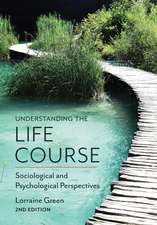The Neurobiology of Criminal Behavior: Gene-Brain-Culture Interaction
Autor Anthony Walsh, Jonathan D. Bolenen Limba Engleză Paperback – 24 mai 2017
| Toate formatele și edițiile | Preț | Express |
|---|---|---|
| Paperback (1) | 469.34 lei 6-8 săpt. | |
| Taylor & Francis – 24 mai 2017 | 469.34 lei 6-8 săpt. | |
| Hardback (1) | 1111.55 lei 6-8 săpt. | |
| Taylor & Francis – 28 feb 2012 | 1111.55 lei 6-8 săpt. |
Preț: 469.34 lei
Nou
Puncte Express: 704
Preț estimativ în valută:
89.81€ • 93.96$ • 74.60£
89.81€ • 93.96$ • 74.60£
Carte tipărită la comandă
Livrare economică 03-17 aprilie
Preluare comenzi: 021 569.72.76
Specificații
ISBN-13: 9781138117198
ISBN-10: 1138117196
Pagini: 232
Dimensiuni: 156 x 234 x 12 mm
Greutate: 0.45 kg
Ediția:1
Editura: Taylor & Francis
Colecția Routledge
Locul publicării:Oxford, United Kingdom
ISBN-10: 1138117196
Pagini: 232
Dimensiuni: 156 x 234 x 12 mm
Greutate: 0.45 kg
Ediția:1
Editura: Taylor & Francis
Colecția Routledge
Locul publicării:Oxford, United Kingdom
Public țintă
Postgraduate and UndergraduateCuprins
Contents: Foreword; Preface; The basic brain; Neurochemistry, gene-cultural coevolution, and criminal behavior; Brain development, abuse-neglect, and criminality; ADHD, comorbid disorders, and criminal behavior; The age-crime curve, puberty, and brain maturation; Substance abuse disorders, epigenetic plasticity, and criminal behavior; Intelligence, nature/nurture, and criminal behavior; Schizophrenia, brain development, and criminal behavior; Criminal violence and the brain; Gender, crime, and the brain; The psychopath: the quintessential criminal; Bibliography; Index.
Notă biografică
Anthony Walsh is a professor of criminology and criminal justice at Boise State University, Idaho, USA. He is the author or co-author of 26 books and over 100 journal articles. His main interests are biosocial criminology, statistics, and the philosophy of law. Jonathan D. Bolan is a graduate student specializing in the neurobiology of criminal behavior.
Recenzii
A Yankee Book Peddler UK Core Title for 2012 'This book presents extremely interesting and valuable information about the importance of neurobiology in the understanding of criminal behavior. It throws new light on many important issues such as the age-crime curve, gender differences in crime, low intelligence and crime, violence, psychopathy, hyperactivity, and the effects of substance abuse. It should be essential reading for all criminologists.' David P. Farrington, University of Cambridge, UK 'For biosocial criminologists, a small but growing group, this book will be a handy resource on very familiar material. For criminologists who are brand new to a neurobiological approach to understanding crime, the book is a fun, handy and relevant overview of material that will get even the most novice of readers up to speed. For the lay person who simply enjoys learning about criminal behavior, The Neurobiology of Criminal Behavior is a great place to start. I strongly recommend this book.' Criminal Law & Criminal Justice Books
Descriere
The main feature of this work is that it explores criminal behaviour from all aspects of Tinbergen's Four Questions. Rather than focusing on a single theoretical point of view, this book examines the neurobiology of crime from a biosocial perspective. It suggests that it is necessary to understand some genetics and neuroscience in order to appreciate and apply relevant concepts to criminological issues. Presenting up-to-date information on the circuitry of the brain, the authors explore and examine a variety of characteristics, traits and behavioural syndromes related to criminal behaviour.










